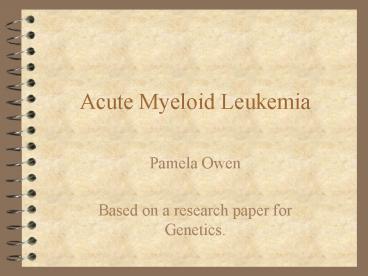Acute Myeloid Leukemia - PowerPoint PPT Presentation
1 / 25
Title:
Acute Myeloid Leukemia
Description:
A rapidly progressing form of leukemia that originates in the bone marrow ... Bone marrow transplants. Radiation treatment ... Bone marrow transplant ... – PowerPoint PPT presentation
Number of Views:1715
Avg rating:3.0/5.0
Title: Acute Myeloid Leukemia
1
Acute Myeloid Leukemia
- Pamela Owen
- Based on a research paper for Genetics.
2
My Motivation!!!
- Genetics
- One of the requirements of Genetics was a paper
on a genetic disorder or disease. - My Uncle
- Was diagnosed in January 97 with Acute Myeloid
Leukemia. He is now in remission!!!
3
Acute Myeloid Leukemia
- What is it?
- Subtypes
- Causation
- Symptoms
- Treatment
- After remission
4
What is it?
- Leukemia
- Acute Leukemia
- Acute Myeloid Leukemia
5
What is it?
- Leukemia
- A type of cancer characterized by the production
of large numbers of immature, abnormal blood
cells that look and act differently from normal
blood cells.
6
What is it?
- Acute Leukemia
- Rapidly progressing form that affects unformed or
primitive cells
7
What is it?
- Acute Myeloid Leukemia
- A rapidly progressing form of leukemia that
originates in the bone marrow - Involves the proliferation of non-functional
white blood cells
8
Subtypes
- Subtypes are categorized by the dominant leukemic
cell type at the time of diagnosis - The 7 subtypes are shown on the following chart
9
Subtypes
- Designation Cell Subtype
- M1 Myeloblastic w/o
maturation - M2 Myeloblastic
w/ maturation - M3
Promyelocytic - M4
Myelomonocytic - M5
Monocytic - M6
Erythroleukemia - M7
Megakaryocytic
10
Causation
- Genetics of the disease
- Genetic risk factors
- Environmental risk factors
11
Causation
- Genetic changes in AML
- Chromosomal changes lead to activation of
oncogenes - Translocation between chromosomes 8 and 12
- Translocation between chromosomes 15 and 17
- Deletion of a segment of chromosome 5 or 7
12
Causation
- Genetic factors that predispose an individual to
AML - Fanconis anemia
- Down syndrome
- Blooms syndrome
13
Causation
- Environmental factors known to cause AML
- Exposure to ionizing radiation
- Exposure to benzene
- Treatment with alkylating agents or procarbazine
- Treatment with other drugs
- Viral oncogenesis (speculative)
14
Symptoms
- Warning signs
- What to expect after diagnosis
15
Symptoms
- Warning signs
- Fatigue
- Prolonged bleeding
- Easy bruising
- Fever
- Frequent minor infections
- Joint pain
16
Symptoms
- Possible side effects of treatment
- Hair loss (alopecia)
- Inflammation of the mouth (stomatitis)
- Difficulty swallowing (dysphagia)
- Nausea and vomiting
- Constipation
- Diarrhea
- Various skin reactions
17
Treatments
- Goal of treatment Remission
- Chemotherapy
- Bone marrow transplants
- Radiation treatment
18
Treatment
- Goal of treatment Remission
- Blood cell counts return to normal
- Leukemic cells can no longer be found in blood or
marrow
19
Treatments
- Chemotherapy
- Induction therapy
- Post-remission therapy
20
Treatments
- Chemotherapy
- Induction therapy
- Initial stage of therapy to eradicate systemic
and marrow-localized leukemic cells leading to
remission - Combination of an anthrocycline antibiotic and a
cytarabine - Both prevent DNA synthesis thus stopping growth
and leading to their death - If remission is not achieved with the first round
of induction therapy, another round is begun
21
Treatments
- Post-remission therapy
- Consolidation therapy
- Goal is to destroy any undetectable leukemic
cells - Many different approaches all of which involve
short doses of intensive therapy - Maintenance therapy
- months to years of less intensive therapy to
prevent further recurrence
22
Treatments
- Bone marrow transplant
- Used as a last resort if 3 rounds of induction
therapy have been unsuccessful - Used as or along with post-remission therapy
- Two types of transplants are used
- Autologous
- Allogeneic
23
Treatments
- Radiation therapy
- Only used in rare cases where leukemic cells are
centralized in one part of the body
24
After remission
- If at any time after remission is achieved a
relapse occurs the initial treatment may be
repeated usually with minor changes in protocol - If after five years of remission there have been
no new outbreaks of leukemic cells the patient is
considered cured
25
Acknowledgements
- Dr. Newman
- Dr. Gabriel
- Dr. Angstadt

